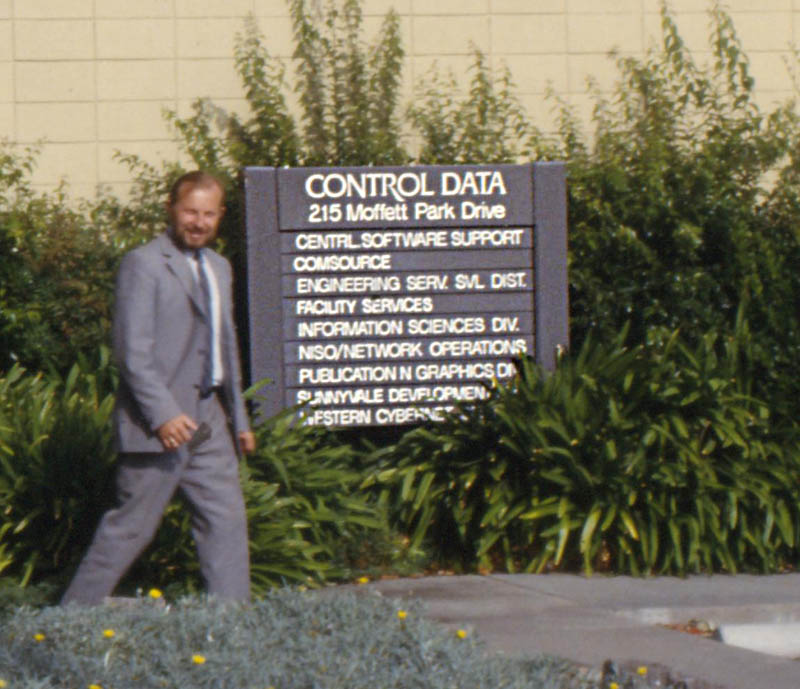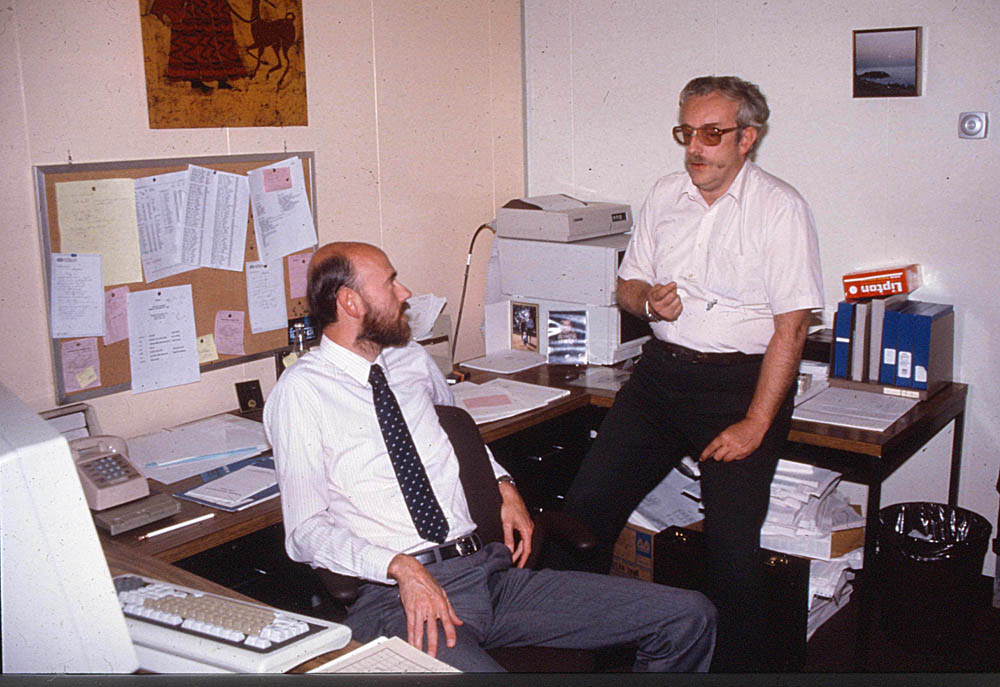A peek inside SVLOPS at 215 Moffett Park Drive

|
The building itself was designed by some architect hired by CDC at its headquaters in Minnesota. This architect came from the design school that
holds windows to be both an energy waster (remember - he's thinking Minnesota) and a potential distraction for employees who might want to see
daylight occasionally.
Thus, in a two-story building, the first floor had no windows at all except in the lobby. On the second floor, windows were both sparse and narrow - sort of like gun slits. The building housed a number of divisions as can be seen on this board outside the lobby. The gentleman on the left is an overseas customer who came to visit the facility. He was accompanied by Martin Suchanek from our German office and who kindly provided both of the images on this page.
|

|
This picture shows two of the denizens who designed and built software for CDC's Cyber computers. This photo was taken on the occasion of a German customer visit, and
such a visit warranted the wearing of a tie to provide an aura of professionalism. I appear to have removed mine, but I have do a white shirt on.
Most of the programming staff worked in cubicles arranged as a "six-pack" within a pod with walls about 6ft high. More senior folks like the two pictured here were priveliged to either have their own office or possibly share two to an office. We see in this office an early example of a "personal computer" - except in those days the term had not yet been popularized by IBM and this device was generally referred to as a micro-computer. (This distinguished it as the smallest member of the hierarchy - microcomputer, minicomputer, mainframe computer and supercomputer) On the left are the keyboard and screen of the operator's console - this was a CDC 721 Viking with green phosphor display on a black background. The keyboard combined elements of both Baroque and Rococo style, there were no less than seven keys marked with some form of left arrow - all of them for different purposes (cursor left, backspace, jump to previous screen, carriage return, etc. etc.) The "driver" for this "terminal" was a Z80 processor which communicated with the CPU proper (also a Z80) which was housed together with the primary disk drive in a large metal box you can see here in the corner of the office next to my right elbow. There are two such boxes, one stacked on top of the other - both contained a drive for an 8" floppy disk. The floppy disks themselves could be single-sided or double-sided - the latter being hardware detectable depending on whether a notch had been cut in a strategic place on the disk sleeve. One disk carried the operating system (CP/M) and the other disk could be used for data files. A double-sided disk could hold just under a megabyte (6.2 mega-bits) The device perched on top of the two disk drive boxes is a boustrophedonic matrix printer built by Okidata. It could print in normal, bold, or italics, but was otherwise severely limited in choice of font or font size.
This whole apparatus was truly the state-of-the-art at that time - communicating in timesharing mode with a supercomputer downstairs. Less fortunate employees got to use a simple dumb terminal with no "local intelligence". Initially every programmer was equipped with a phone line and the terminal was "dialed in" via modem to a multiplexor in the downstairs machine room. Then somebody came up with the idea of laying one long co-axial cable in the ceiling above all the offices and having each user connect to this cable by a "stinger" that hooked onto the cable and established electrical connection with both the shield and core by means of this stinger. An intelligent device connected to the end of the cable separated out the different connections based on handshakes, collision detection, re-transmission and related protocols. They called it Ethernet. Even the use of a terminal in timesharing mode was a pretty neat trick in the early part of CDC's tenure in this building. The first "portable" terminals were things like the "Execuport" (a large electric typewriter adapted to work with a modem) or the Texas Instruments Silent 700 which was truly portable - using a roll of thermal paper and with a built-in acoustic modem. Subsequently, CRT's (also known as Glass Teletypes) heralded the dawn of paperless computing. Prior to that, programmers typed their code into punched cards - there was an electric keypunch at each corner of the building for communal use, and the programmer would submit his (or her) deck of cards for batch processing at the counter downstairs - and collect any printed output some hours later or even the next day if it was a "big" job scheduled for overnight processing by the evening or graveyard shift. Managers did not use computers. They had their stuff typed by secretaries. The latter also answered phones for the department if you were not at your desk to pick it up, and left a little pink slip for you with any message - as seen here pinned to the cork board on the wall. Voice-mail has relegated such slips to nothing more than an historical curiosity. Backup of files was assured by keeping critical listings - seen here stacked under the table. Note also the slim device positioned under the telephone. This was a "squawk box" (referred to now as a speaker phone). This particular model was technically illegal because it required no separate power supply (no "brick" with extra wires taking up space on a wall outlet) but powered its amplifier using line voltage off the telephone line. Other models did indeed require a separate brick, but this particular model was highly prized for its simple clutter-free installation. Return to Home Page |